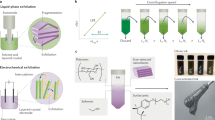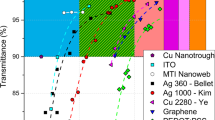Abstract
Carrier transport processes in assemblies of nanostructures rely on morphology-dependent and hierarchical conduction mechanisms, whose complexity cannot be captured by current modelling approaches. Here we apply the concept of complex networks to modelling carrier conduction in such systems. The approach permits assignment of arbitrary connectivity and connection strength between assembly constituents and is thus ideal for nanostructured films, composites and other geometries. Modelling of simplified rod-like nanostructures is consistent with analytical solutions, whereas results for more realistic nanostructure assemblies agree with experimental data and reveal conduction behaviour not captured by previous models. Fitting of ensemble measurements also allows the conduction properties of individual constituents to be extracted, which are subsequently used to guide the realization of transparent electrodes with improved performance. A global optimization process was employed to identify geometries and properties with high potential for transparent conductors. Our intuitive discretization approach, combined with a simple solver tool, allows researchers with little computational experience to carry out realistic simulations.
This is a preview of subscription content, access via your institution
Access options
Access Nature and 54 other Nature Portfolio journals
Get Nature+, our best-value online-access subscription
$29.99 / 30 days
cancel any time
Subscribe to this journal
Receive 12 print issues and online access
$259.00 per year
only $21.58 per issue
Buy this article
- Purchase on Springer Link
- Instant access to full article PDF
Prices may be subject to local taxes which are calculated during checkout




Similar content being viewed by others
Data availability
The datasets generated during and/or analysed during the current study are available online at https://doi.org/10.6084/m9.figshare.c.4879863.
Code availability
Sample code employed in this work is available in the Supplementary Information and additional examples are available at https://doi.org/10.6084/m9.figshare.c.4879863.
References
Hempel, M., Nezich, D., Kong, J. & Hofmann, M. A novel class of strain gauges based on layered percolative films of 2D materials. Nano Lett. 12, 5714–5718 (2012).
Zhang, L. L. & Zhao, X. S. Carbon-based materials as supercapacitor electrodes. Chem. Soc. Rev. 38, 2520–2531 (2009).
Law, M., Greene, L. E., Johnson, J. C., Saykally, R. & Yang, P. Nanowire dye-sensitized solar cells. Nat. Mater. 4, 455–459 (2005).
Park, S., Vosguerichian, M. & Bao, Z. A review of fabrication and applications of carbon nanotube film-based flexible electronics. Nanoscale 5, 1727–1752 (2013).
Blom, P. W. M., Mihailetchi, V. D., Koster, L. J. A. & Markov, D. E. Device physics of polymer:fullerene bulk heterojunction solar cells. Adv. Mater. 19, 1551–1566 (2007).
Manning, H. G. et al. Emergence of winner-takes-all connectivity paths in random nanowire networks. Nat. Commun. 9, 3219 (2018).
Yao, H., Hempel, M., Hsieh, Y. P., Kong, J. & Hofmann, M. Characterizing percolative materials by straining. Nanoscale 11, 1074–1079 (2018).
Ni, X., Hui, C., Su, N., Jiang, W. & Liu, F. Monte Carlo simulations of electrical percolation in multicomponent thin films with nanofillers. Nanotechnology 29, 075401 (2018).
White, S. I. et al. Electrical percolation behavior in silver nanowire–polystyrene composites: simulation and experiment. Adv. Funct. Mater. 20, 2709–2716 (2010).
Li, J., Ray, B., Alam, M. A. & Ostling, M. Threshold of hierarchical percolating systems. Phys. Rev. E 85, 021109 (2012).
Sillin, H. O. et al. A theoretical and experimental study of neuromorphic atomic switch networks for reservoir computing. Nanotechnology 24, 384004 (2013).
da Rocha, C. G. et al. Ultimate conductivity performance in metallic nanowire networks. Nanoscale 7, 13011–13016 (2015).
Chen, T. W., Hsieh, Y. P. & Hofmann, M. Ad-layers enhance graphene’s performance. RSC Adv. 5, 93684–93688 (2015).
Huang, J. C. Carbon black filled conducting polymers and polymer blends. Adv. Polym. Technol. 21, 299–313 (2002).
Zhu, C. et al. Strain engineering in perovskite solar cells and its impacts on carrier dynamics. Nat. Commun. 10, 815 (2019).
Qazilbash, M. M. et al. Mott transition in VO2 revealed by infrared spectroscopy and nano-imaging. Science 318, 1750–1753 (2007).
Zhang, Y. B., Brar, V. W., Girit, C., Zettl, A. & Crommie, M. F. Origin of spatial charge inhomogeneity in graphene. Nat. Phys. 5, 722–726 (2009).
Demis, E. C. et al. Atomic switch networks—nanoarchitectonic design of a complex system for natural computing. Nanotechnology 26, 204003 (2015).
Bauhofer, W. & Kovacs, J. Z. A review and analysis of electrical percolation in carbon nanotube polymer composites. Compos. Sci. Technol. 69, 1486–1498 (2009).
Albert, R. & Barabasi, A. L. Statistical mechanics of complex networks. Rev. Mod. Phys. 74, 47–97 (2002).
Papo, D., Buldú, J. M., Boccaletti, S. & Bullmore, E. T. Complex network theory and the brain. Phil. Trans. R. Soc. Lond. B 369, 20130520 (2014).
Lee, D., Kahng, B., Cho, Y. S., Goh, K. I. & Lee, D. S. Recent advances of percolation theory in complex networks. J. Korean Phys. Soc. 73, 152–164 (2018).
Kryven, I. Bond percolation in coloured and multiplex networks. Nat. Commun. 10, 404 (2019).
McRae, B. H., Dickson, B. G., Keitt, T. H. & Shah, V. B. Using circuit theory to model connectivity in ecology and conservation. Ecology 10, 2712–2724 (2008).
Anantharaman, R., Hall, K., Shah, V. & Edelman, A. Circuitscape in Julia: high performance connectivity modelling to support conservation decisions. Preprint at https://arXiv.org/abs/1906.03542 (2019).
Balberg, I., Binenbaum, N. & Anderson, C. H. Critical-behavior of the two-dimensional sticks system. Phys. Rev. Lett. 51, 1605–1608 (1983).
Li, J. & Zhang, S. L. Conductivity exponents in stick percolation. Phys. Rev. E 81, 021120 (2010).
Mutiso, R. M. & Winey, K. I. Electrical percolation in quasi-two-dimensional metal nanowire networks for transparent conductors. Phys. Rev. E 88, 032134 (2013).
Khanarian, G. et al. The optical and electrical properties of silver nanowire mesh films. J. Appl. Phys. 114, 749–755 (2013).
Goh, G. L., Saengchairat, N., Agarwala, S., Yeong, W. Y. & Tran, T. Sessile droplets containing carbon nanotubes: a study of evaporation dynamics and CNT alignment for printed electronics. Nanoscale 11, 10603–10614 (2019).
Frey, E., Tauber, U. C. & Schwabl, F. Crossover from isotropic to directed percolation. Phys. Rev. E 49, 5058–5072 (1994).
Wu, B., Geng, D. & Liu, Y. Evaluation of metallic and semiconducting single-walled carbon nanotube characteristics. Nanoscale 3, 2074–2085 (2011).
Rylkov, V. V. et al. in Novel Magnetic Nanostructures 427–464 (Elsevier, 2018).
Rintoul, M. D. & Torquato, S. Precise determination of the critical threshold and exponents in a three-dimensional continuum percolation model. J. Phys. A 30, L585–L592 (1997).
Avizienis, A. V. et al. Morphological transitions from dendrites to nanowires in the electroless deposition of silver. Cryst. Growth Des. 13, 465–469 (2013).
Tersoff, J. Contact resistance of carbon nanotubes. Appl. Phys. Lett. 74, 2122–2124 (1999).
Estrada, D. & Pop, E. Imaging dissipation and hot spots in carbon nanotube network transistors. Appl. Phys. Lett. 98, 073102 (2011).
Hsieh, Y. P. et al. Direct deposition of single-walled carbon nanotube thin films via electrostatic spray assisted chemical vapor deposition. Nanotechnology 20, 065601 (2009).
De, S., King, P. J., Lyons, P. E., Khan, U. & Coleman, J. N. Size effects and the problem with percolation in nanostructured transparent conductors. ACS Nano 4, 7064–7072 (2010).
Mutiso, R. M., Sherrott, M. C., Rathmell, A. R., Wiley, B. J. & Winey, K. I. Integrating simulations and experiments to predict sheet resistance and optical transmittance in nanowire films for transparent conductors. ACS Nano 7, 7654–7663 (2013).
Znidarsic, A. et al. Spatially resolved transport properties of pristine and doped single-walled carbon nanotube networks. J. Phys. Chem. C. 117, 13324–13330 (2013).
Nair, R. R. et al. Fine structure constant defines visual transparency of graphene. Science 320, 1308 (2008).
Turner, P., Hodnett, M., Dorey, R. & Carey, J. D. Controlled sonication as a route to in-situ graphene flake size control. Sci. Rep. 9, 8710 (2019).
Wang, S., Yi, M. & Shen, Z. G. The effect of surfactants and their concentration on the liquid exfoliation of graphene. RSC Adv. 6, 56705–56710 (2016).
Ellmer, K. Past achievements and future challenges in the development of optically transparent electrodes. Nat. Photon. 6, 808–816 (2012).
Mutiso, R. M. & Winey, K. I. Electrical percolation in quasi-two-dimensional metal nanowire networks for transparent conductors. Phys. Rev. E 88, 032134 (2013).
De, S. et al. Flexible, transparent, conducting films of randomly stacked graphene from surfactant-stabilized, oxide-free graphene dispersions. Small 6, 458–464 (2010).
Doherty, E. M. et al. The spatial uniformity and electromechanical stability of transparent, conductive films of single walled nanotubes. Carbon 47, 2466–2473 (2009).
De, S. et al. Silver nanowire networks as flexible, transparent, conducting films: extremely high DC to optical conductivity ratios. ACS Nano 3, 1767–1774 (2009).
Scardaci, V., Coull, R. & Coleman, J. N. Very thin transparent, conductive carbon nanotube films on flexible substrates. Appl. Phys. Lett. 97, 023114 (2010).
Acknowledgements
M.H. acknowledges funding from the Ministry of Science and Technology (107-2112-M-002 -004 -MY3). Y.-P.H. acknowledges funding from Academia Sinica (AS-iMATE-108-32) and the Ministry of Science and Technology.
Author information
Authors and Affiliations
Contributions
H.Y. developed methodology, software and analysis and wrote the original draft, Y.-P.H. provided methodology, experimental resources, revisions and supervision, J.K. contributed conceptualization, experimental ressources and critical review, M.H. aided in formal analysis, visualization, project management and revision.
Corresponding authors
Ethics declarations
Competing interests
The authors declare no competing interests.
Additional information
Publisher’s note Springer Nature remains neutral with regard to jurisdictional claims in published maps and institutional affiliations.
Supplementary information
Supplementary Information
Supplementary text, Table 1 and Figs. 1–5.
Supplementary Video 1
Animated visualization of percolation pathways in composite of resistive matrix with conductive fillers corresponding to the inset of Fig. 3a.
Rights and permissions
About this article
Cite this article
Yao, H., Hsieh, YP., Kong, J. et al. Modelling electrical conduction in nanostructure assemblies through complex networks. Nat. Mater. 19, 745–751 (2020). https://doi.org/10.1038/s41563-020-0664-1
Received:
Accepted:
Published:
Issue Date:
DOI: https://doi.org/10.1038/s41563-020-0664-1
This article is cited by
-
Direct growth of single-metal-atom chains
Nature Synthesis (2022)
-
In situ synthesis of hierarchically-assembled three-dimensional ZnS nanostructures and 3D printed visualization
Scientific Reports (2022)
-
The electrical conductivity of solution-processed nanosheet networks
Nature Reviews Materials (2021)



